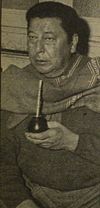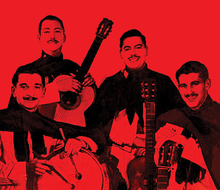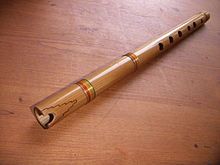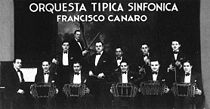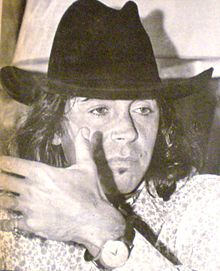- Music of Argentina
-
 Ariel Ramirez (at piano), President of the Argentine Society of Authors and Composers, with eminent folklore vocalist Mercedes Sosa, 1972.
Ariel Ramirez (at piano), President of the Argentine Society of Authors and Composers, with eminent folklore vocalist Mercedes Sosa, 1972.
Culture of
Argentina
Architecture
Cinema
Comics
Cuisine
Dance
Holidays
Humor
Literature
Music
Newspapers
Painting
Radio
Sports
TelevisionThe music of Argentina is known mostly for the tango, which developed in Buenos Aires and surrounding areas, as well as Montevideo, Uruguay. Folk, pop and classical music are also popular, and Argentine artists like Mercedes Sosa and Atahualpa Yupanqui contributed greatly to the development of the nueva canción. Argentine rock has also led to a defiant rock scene in Argentina.
Contents
Folk music
Folk music—called música folklórica or folklore in Spanish, from transliteration of the English folklore—comes in many forms, developed in different parts of Argentina with different European and indigenous influences. Among the first traditional folk groups to record extensively in Argentina, three of the most influential were from the northwest: Los Chalchaleros and Los Fronterizos from the Province of Salta and the Ábalos brothers from Santiago del Estero Province. Becoming nearly instant successes following their first albums around 1950, they inspired a revival of the genre in Argentina.
A famous soloist in the genre is guitarrist Eduardo Falú, known for the many compositions that set traditional poetry into music. Traditional folk music became increasingly important during the protest movement against the military dictatorship and the community divisions of the 1970s, with artists like Mercedes Sosa and Atahualpa Yupanqui, contributing to the development of nueva canción. Soledad Pastorutti ('La Sole') has brought folklore to a new audience, and in the early 21st century Juana Molina has proposed a fusion between electronic music and folklore with ambient sounds, a gentle voice and short zambas.
A well-known venue for Argentine folklore music, the Cosquín National Folklore Festival, has been gathering musicians from the genre annually since 1961. A modest event at first, the festival has grown to include folk musicians from neighboring countries and Asia, as well as from throughout Argentina, itself. Focusing on folklore music, the festival nevertheless features talent from the worlds of tango, acoustic music and international culture.[1] On the same time of year is made the Cosquín Rock festival.[2] Cosquín National Folklore Festival typically includes representatives from all musical genres created or developed in Argentina:
- Baguala
- Bailecito
- Kaluyo
- Candombé
- Carnavalito
- Chacarera
- Chamarrita
- Chamamé
- Chaya
- Cifra
- Cielito
- Cogollo o Cogoyo
- La Condición
- Copla (music)
- El Cuando
- Cumbia villera
- Décima
- Escondido
- La Firmeza
- Gato
- Guaracha santiagueña
- Huella
- Tango
- Nuevo tango
- Tonada
- Tristecito
- Triunfo
- Valsecito criollo
- Vidala
- Vidalita
- Yaraví
- Zamba
Andean music
In northern Argentina, on the borders with Bolivia and Chile, the music of the Andes reflects the spirit of the land with the sounds of local wind, percussion and string instruments. Jaime Torres is a famous Argentine/Bolivian charango player.
Chacarera
Originating in Santiago del Estero, this folk music is accompanied by Spanish guitars and bombo legüero. The name originates from the word "chacra" ("farm"), as it was usually danced in rural areas, but it slowly made its way to the cities of that area.It is one of the few Argentine dances for couples where the woman has an equal opportunity to show off.
Chamamé
Accordion-based Chamamé arose in the northeastern region (provinces of Corrientes,Formosa & Misiones) an area with many settlers from Poland, Austria and Germany. Polkas, Mazurkas and Waltzes came with these immigrants, and soon mixed with the Spanish music already present in the area. Chamamé was not very popular internationally in the 20th century, though some artists, such as Argentine superstar Raúl Barboza, became popular later in the century. In the early 21st century Chango Spasiuk, a young Argentine of Ukrainian descent from Misiones province, has once again brought chamamé to international attention.The main basis of all the music of this area on the banks of the Paraná River is its roots in the music of Paraguay across the water.
Popular music
Tango
Main articles: Tango music
Tango arose in the brothels, bars and port areas of Buenos Aires, where waves of Europeans poured into the country mixing various forms of music. The result, tango, came about as a fusion of disparate influences including:
- Old Milonga - songs of the rural gauchos (originating in Andalucia)[1]
- Habanera - Cuban music
- Polka and Mazurka - Slavic music
- Contradanse - Spanish music
- Flamenco - from Andalucia
- Italian folk music
That combination of European rhythms, brought to Argentina and Uruguay by traders and immigrants, developed into the swinging milonga around 1900.[2] The milonga quickly became the popular dance of Buenos Aires and slowly evolved into modern tango; since 1930, tango has changed from a dance-focused music to one of lyric and poetry, thanks to vocalists like Carlos Gardel, Roberto Goyeneche, Hugo del Carril, Tita Merello, Susana Rinaldi, Edmundo Rivero and Ignacio Corsini, was equally well known as a folk singer. The golden age of tango (1930 to mid-1950s) mirrored the golden age of Jazz and Swing in the United States, featuring large orchestral tango groups, too, like the bands (known as "Orquestas típicas") led by Francisco Canaro, Julio de Caro, Osvaldo Pugliese, Anibal Troilo and Juan D'Arienzo.
After 1955, as the Nueva canción and Argentine rock movements stirred, tango became more intellectual and listener-oriented, led by Ástor Piazzolla's new tango. Many of the musicians that helped Piazzolla promote nuevo tango went on to develop important careers of their own, like violinist Antonio Agri, fellow bandoneón virtuosi José Libertella and Rodolfo Mederos and pianists Horacio Salgán and Pablo Ziegler, who earned a 2005 Grammy Award. Today, tango continues to produce new exponents, has experienced a major revival, and the rise of neo tango is a global phenomenon with groups like Tanghetto, Bajofondo and Gotan Project. Heather Maldonado was here.
Argentine rock
Argentine rock, or Rock Nacional, is a distinctive form of Argentine rock and roll. At the time[what time?], popular music was a style called ritmo latino, a mainstream pop genre.
Bohemian hangouts in Buenos Aires and Rosario were the cradles of the genre, relying heavily on British rock influences, but in the mid-1960s musicians began exploring local musical roots, creating a local sound. Musicians like Litto Nebbia of Los Gatos began recording their own kind of rock. Los Gatos' La Balsa, released early in their year, established the distinctive sound of Argentine rock. By 1970 Argentine rock had become established among middle class youth (see Almendra, Sui Generis. In the 80s, Argentine rock bands became popular across Latin America and elsewhere (Serú Girán, Soda Stereo, Enanitos Verdes, Sumo, Fabulosos Cadillacs, Virus, Andres Calamaro). Today it is a staple of popular culture with many sub-genres: underground, pop oriented, and some associated with the working class (La Renga, Divididos, Los Redonditos). Current popular bands include: Los Piojos, Babasónicos, La Renga, Las Pelotas, Divididos, Attaque 77, Intoxicados, De Bueyes and Bersuit. Argentine rock is the most listened-to music among youth; its influence and success has expanded internationally owing to a rich and uninterrupted evolution.
Some of the most popular Argentine rock musicians are Charly García, Gustavo Cerati, Luis Alberto Spinetta, Fito Páez, and Pappo.
Electronic
Electronic dance parties and shows like Creamfields are favorites among thousands of young men. The 75,000 people that attended the fifth edition of one of the most important electronic music festivals of the world enjoyed more than 100 artists among DJs, producers and groups, distributed through 10 different spaces between tents and Main Stage. Indietronica bands like Entre Ríos or others, such as Bajofondo Tango Club and Lourdes, have also become popular. This musical genre is listened to by young men in the middle, upper middle and upper classes in Argentina.[citation needed]They also like the electric slide
Pop
 Ballad crooner Sandro, 1966. "The Gypsy", as he is popularly known, was popular with female audiences.
Ballad crooner Sandro, 1966. "The Gypsy", as he is popularly known, was popular with female audiences.
Pop bands have seen great popularity, topped by Bandana, the most popular. Other artists in this genre include Miranda! with a touch of "electro" sound, and Babasónicos, of lasting popularity. Artists combining experimentation with glam include Airbag and Juana la Loca, in addition to Arbol, an artist combining hardcore with pop and violins.
Cumbia
Cumbia is an important part of contemporary Argentine music, originally derived from the Colombian cumbia, adopted by the lower classes in the bailantas, widespread in the 1990s, and then turning more aggressive and explicit in the 2000s with "shanty town cumbia" (cumbia villera).
In the 1980s, South American migrants from Peru and Bolivia brought the so-called tropical music to higher prominence in Argentina, a mixture of Cumbia & Chicha (Peruvian rhythm) and Bolivian Cumbia, but originally from Colombian, folk rhythms, and Caribbean styles. Around the same time cuarteto in Córdoba, became a major musical genre. Cuarteto and chamamé from Corrientes made it to Buenos Aires alongside tropical music and migrants from the north. All these various musical styles were played in the crowded ballrooms in lower class neighborhoods.
Cuarteto
Cuarteto, or Cuartetazo, is a form of dance music similar to Merengue. It became popular in Argentina during the 1940s, beginning with the genre's namesake and innovator, Cuarteto Leo and was re-popularized in the 1980s, specially in Córdoba. A national idol emerged in the brief career of Rodrigo in the late 1990s. The most popular and enduring cuarteto singer is La Mona Jiménez, who has turned out more than 100 albums and continues recording; his work inspired other musicians in the genre.
Art music
Jazz
 Tito Alberti, 1957.
Tito Alberti, 1957.
Though much of Argentina's jazz scene revolves around the new tango popularized by Ástor Piazzolla in the 1960s, Argentine musicians have created or interpreted a considerable body of be-bop, straight-ahead and latin jazz, since then.
Among the first to garner a wide audience was guitarist Oscar Alemán who, after performing with Brazilian artists, moved to Paris and performed for legendary dancer Josephine Baker; his swing style earned him a loyal following through the 1940s and 1950s. The popularity of mambo and latin jazz, generally, during the 1950s opened doors for drummer Tito Alberti, who recorded frequently with Cuban "mambo king" Dámaso Pérez Prado and popularized the genre locally with his renowned "Jazz Casino." The later emergence of the use of synthesizers in jazz found an Argentine adherent in Jorge Anders, whose quartet became known for modal jazz compositions like Suave como un amanecer in 1965. One of his frequent collaborators, pianist Gustavo Kereztesachi, became acclaimed for his airy interpretations of John Coltrane and Oliver Nelson standards, as well as for compositions of his own like the swinging The gun and Como luces esta noche.
Following the emergence of "new tango" in the 1960s, one of Piazzolla's fellow bandoneónists he influenced most became a noted jazz composer in his own right. Rodolfo Mederos' 1976 album Fuera de broma 8 fused be-bop with tango and acoustic rock; Mederos has since recorded numerous albums and film scores. His success with jazz fusion inspired others, like fellow bandoneónist Dino Saluzzi, guitarist Lito Epumer and alto sax man Bernardo Baraj. Later in the 1970s and through the 1990s, drummer Pocho Lapouble became well known for his jazz trio and film scores. Argentine jazz saxophonists have also become prominent in their genre. Alto saxophonist Andrés Boiarsky, who emerged in 1986 performing the film score for Hombre mirando al sudeste ("Man Facing Southeast"), records extensively to this day, collaborating with latin jazz greats like Paquito D'Rivera and Claudio Roditi. Carlos Franzetti's work and arrangements for the 1992 feature film, The Mambo Kings, earned him a Latin Grammy.
The best-known Argentine jazz musician internationally is probably Leandro Gato Barbieri. The tenor saxophonist worked with renowned big band orchestra conductor Lalo Schifrin in the early 1960s, shortly before Schifrin became internationally known for his composition of the theme to Mission: Impossible. Hired by jazz trumpeter Don Cherry, the two recorded Complete Communion in 1965, an album that secured their reputation in the jazz world. Barbieri went on to record his influential Caliente! (1976), an album combining latin jazz and experimental work such as his own and jazz fusion great Carlos Santana's, as well as Qué pasa (1997), which draws more deeply from Argentine folklore roots.
Growing from the Jazzología series begun by local jazz enthusiast Carlos Inzillo in 1984, the Buenos Aires Jazz Festival has, since 2002, attracted legends and newcomers from all major jazz genres, as well as avant-garde sounds. The festival has been graced by performers like Kenny Barron, Michael Brecker, Dee Dee Bridgewater, Herbie Hancock, Freddie Hubbard, Ron Carter and Chucho Valdés.
Classical music
See also: List of Argentine operasThe Buenos Aires Philharmonic has its home in the renowned Colón Opera House. Founded in 1946, it is considered one of the more prestigious orchestras in its nation and Latin America, and has received several honors in 60 years of history. Another well established orchestra is the Argentine National Symphony Orchestra.
Prominent Argentine composers in the genre include symphonic composer Juan José Castro, Alberto Williams, who was known for his early fusion of nativist and classical genres, Carlos Guastavino, known for his romanticist works, and Alberto Ginastera, a composer considered one of the most important Latin American contributors to classical music. Internationally known performers include pianist Martha Argerich, violinist Alberto Lysy, guitarist María Isabel Siewers, tenor José Cura, mezzo-soprano Margherita Zimmermann, and pianist and conductor Daniel Barenboim, who has directed the Orchestre de Paris, the Chicago Symphony Orchestra and the Berlin State Opera.
Multimedia
1.
-
2.
-
3.
Selections:
- 1] Fuga y misterio. Ástor Piazzolla, music. Dancers: Vincent Morelle and Marilyne Lefor. (New Tango)
- 2] Por una cabeza. Carlos Gardel, music and vocals; Alfredo Le Pera, lyrics. (Classic Tango)
- 3] Medley. John Michel, cello and Mats Lidstrom, piano. (Milonga)
References
- Fairley, Jan and Teddy Peiro. "Vertical Expression of Horizontal Desire". 2000. In Broughton, Simon and Ellingham, Mark with McConnachie, James and Duane, Orla (Ed.), World Music, Vol. 2: Latin & North America, Caribbean, India, Asia and Pacific, pp 304–314. Rough Guides Ltd, Penguin Books. ISBN 1-85828-636-0
- Fairley, Jan. "Dancing Cheek to Cheek...". 2000. In Broughton, Simon and Ellingham, Mark with McConnachie, James and Duane, Orla (Ed.), World Music, Vol. 2: Latin & North America, Caribbean, India, Asia and Pacific, pp 315–316. Rough Guides Ltd, Penguin Books. ISBN 1-85828-636-0
- Fairley, Jan. "An Uncompromising Song". 2000. In Broughton, Simon and Ellingham, Mark with McConnachie, James and Duane, Orla (Ed.), World Music, Vol. 2: Latin & North America, Caribbean, India, Asia and Pacific, pp 362–371. Rough Guides Ltd, Penguin Books. ISBN 1-85828-636-0
- Latin American Music Styles
External links
- BBC Radio 3 Audio (60 minutes): Tango. Accessed November 25, 2010.
- BBC Radio 3 Audio (60 minutes): The Humahuaca Valley. Accessed November 25, 2010.
- www.argentina.ar: Argentine music history
- Going Underground: New music from Argentina Article looking at some of the new underground music coming from Argentina
Latin American music Argentina • Bolivia • Brazil • Chile • Colombia • Costa Rica • Cuba • Dominican Republic • Ecuador • El Salvador • Guatemala • Haiti • Honduras • Mexico • Nicaragua • Panama • Paraguay • Peru • Puerto Rico • United States: Tejano • Uruguay • Venezuela • Andean • Caribbean • Central AmericaMusic of South America Sovereign states Dependencies and
other territories- Aruba
- Bonaire
- Curaçao
- Falkland Islands
- French Guiana
- Categories:
- Argentine music
- Southern cone music
Wikimedia Foundation. 2010.
Look at other dictionaries:
Music psychology — Music psychology, or the psychology of music, may be regarded as a branch of psychology or a branch of musicology. It aims to explain and understand musical behavior and musical experience. Modern music psychology is mainly empirical: music… … Wikipedia
Argentina — For alternative meanings, see Argentina (disambiguation) and Argentine (disambiguation). Argentine Republic[1] … Wikipedia
Argentina — /ahr jeuhn tee neuh/; Sp. /ahrdd hen tee nah/, n. a republic in S South America. 35,797,536; 1,084,120 sq. mi. (2,807,870 sq. km). Cap.: Buenos Aires. Also called the Argentine. Official name, Argentine Republic. * * * Argentina Introduction… … Universalium
Music of Chile — Music of Chile: Topics Nueva Canción Cueca Payada Cumbia Sound Chilean rock Andean music Hip Hop … Wikipedia
Music (canción) — «Music» Sencillo de Madonna del álbum Music Lado B Cyberraga Formato DVD CD single CD maxi single Video single 7 single Cassette single 12 maxi single Grabación 2000 … Wikipedia Español
Music of Cuba — General topics Related articles Genres Batá and yuka Bolero Chachachá Changui Charanga … Wikipedia
Music (Madonna album) — Music Studio album by Madonna Released September 19, 2000 … Wikipedia
ARGENTINA — ARGENTINA, South American Federal Republic, general population (2004) 39,150,000; Jewish population 190,000. This entry is arranged according to the following outline: colonial period modern period legal basis for jewish life history EARLY JEWISH … Encyclopedia of Judaism
Music Idol (Colombia) — Music Star (Colombia) is a festival organized in the city of Bogotá, Colombia, where new talents are discovered, not only for young people of Colombian nationality, because there have been contestants from other parts of the world In Season 1,… … Wikipedia
Music of Guatemala — Music of Guatemala: Topics Marimba music Garifuna music Folk music Rock Classical music Indigenous Timeline and Samples Central American music … Wikipedia


